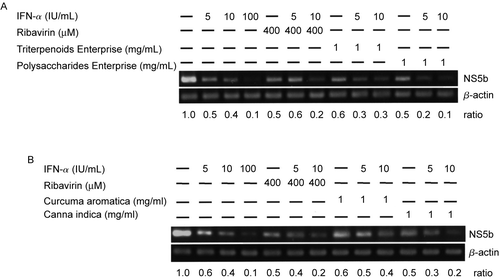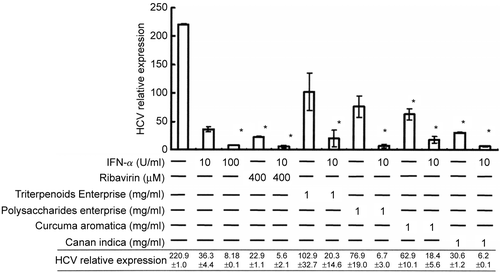Figures & data
Table 1. Herbal extracts, fungal extracts, and purified components from herbal medicines and their cytotoxic effects on HCV-Huh-7 cells, inhibitory effects on subgenomic HCV RNA replication and synergistic effects with IFN-α.
Table 2. Effects of fungal and herbal extracts on cytotoxicity of Huh-7 cells containing the HCV subgenomic replicon.
Table 3. Effects of herbal extracts in conjunction with IFN-α on cytotoxicity of Huh-7 cells containing the HCV subgenomic replicon.
Figure 1. Replication inhibition effect on Huh-7 cells containing an HCV subgenomic replicon by purified components of herbal medicines. (A) Huh-7 cells (7 × 106/ml) containing an HCV subgenomic replicon were treated with sailosaponin C, sailosaponin A, glycyrrhizin, or paeoniflorin at the concentrations indicated in the figure for 48 h. For analysis of NS5B, 1 μg RNA was extracted for RT reactions and PCR. PCR products (4 μl) were applied to a 1.5% agarose gel. As a control, 1 μg RNA was extracted from untreated Huh-7 cells containing the HCV subgenomic replicon (Lane 1). (B) HCV-Huh-7 cells were treated with purified components of herbal medicines in the presence of 10 IU/ml IFN-α as above. (C) HCV-Huh-7 cells treated with herbal extracts in the presence of 10 IU/ml IFN-μ. Ratio levels presented are the means of triplicates. Cell treatment at each concentration has been repeated in three separate experiments.

Figure 2. Replication inhibition effect on Huh-7 cells containing an HCV subgenomic replicon by herbal extracts in combination with IFN-α. (A) Huh-7 cells (7 × 106/ml) containing an HCV subgenomic replicon were treated with Triterpenoids Enterprise (Shuang Hor Lingzhi®), Polysaccharides Enterprise (Shuang Hor Supreme Lingzhi®) alone or in combination with IFN-α for 48 h at the concentrations given in the figure, and 1 μg RNA was extracted to perform RT reactions and PCR for NS5B. (B) Huh-7 cells (7 × 106/ml) containing an HCV subgenomic replicon were treated with extracts of C. aromatica or C. indica alone or in combination with IFN-α for 48 h at the concentrations given in the figure, and 1 μg RNA was extracted to perform RT and PCR. RCR products (4 μl) were applied to a 1.5% agarose gel. As a negative control, 1 μg RNA was extracted from untreated Huh-7 cells containing the HCV subgenomic replicon (lane 1). As a positive control, RNA was also extracted from HCV-Huh-7 cells treated with IFN-α alone or in combination with ribavirin. Cell treatment at each concentration has been repeated in three separate experiments.

Figure 3. Replication inhibition effect on Huh-7 cells containing an HCV subgenomic replicon by herbal and fungal extracts with real-time quantitative PCR analysis. HCV-Huh-7 cells (7 × 106/ml) were treated with Triterpenoids Enterprise (Shuang Hor Lingzhi®), Polysaccharides Enterprise (Shuang Hor Supreme Lingzhi®), or extracts from C. aromatica or C. indica at 1 mg/ml for 48 h, and 1 μg RNA was extracted to perform real-time quantitative PCR. The relative HCV RNA titers were compared with those of untreated cells. Relative HCV RNA titers of cells treated with the four herbal extracts in combination with 10 IU/ml of IFN-α were also obtained as indicated. Results are expressed as the mean ± standard deviation for three replicate wells. Cell treatment at each concentration has been repeated in three separate experiments.
